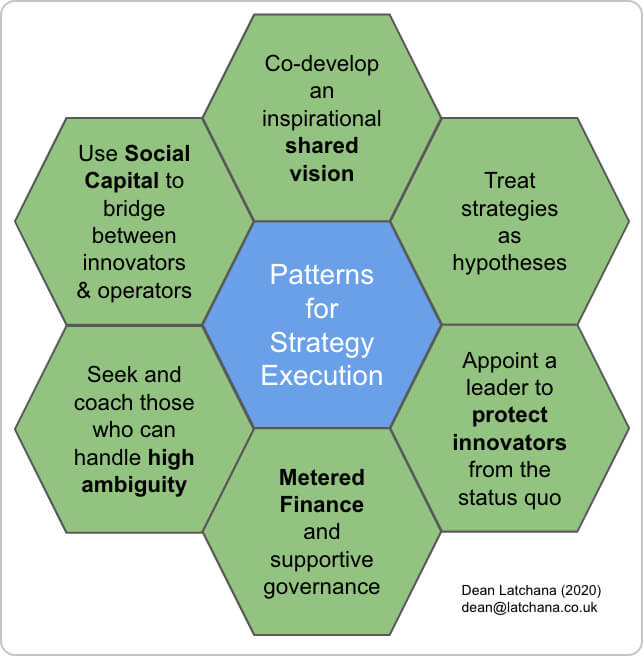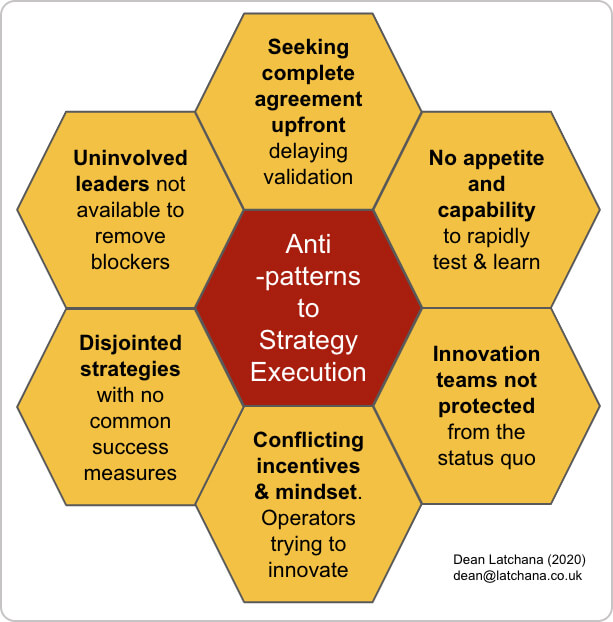When looking for information about strategy execution, we are sure you will find endless resources on the internet. Among all the tips, tricks, best practices, etc., it gets harder and harder to spot authentic information.
As one of our commitments at Businessmap is always to deliver valuable content to our audience, we are happy to share the following post with you.
Special thanks to Dean Latchana for agreeing to republish his posts on the most common patterns and anti-patterns for strategic execution!
I'm often asked by leaders to support their organizations to execute their strategies. So over the years, I've come to recognize common patterns and anti-patterns for strategic execution.
The former create the mindset, ways of working, and conditions for more effective strategic execution while the latter hamper organizations from delivering upon their strategies.
But first what is a strategy and how does it relate to organizational transformation?
Strategy and Organisational Transformation
"A strategy is something which gives consistency over time and contains the essence of how you're going to be different"
Gary Hamel
An organization is likely to be employing multiple strategies. Each strategy is a vehicle for organizational transformation and value creation. They can fall into these categories:
- Business - In a rapidly changing world, what's right for the business and the colleagues? Yesterday's success may not be tomorrow's.
- Competitive market - How should the company differentiate itself? What privileged insights or capabilities does it want to bring to bear?
- Customers/stakeholders - What new or existing wants, needs and desires does the company want to address? Which ones should it stop serving?
Uncertainty means an organization should test & learn which strategies will fit the organization's vision. A vision describes what the organization wants to become; it's an aspirational and motivational indeterminate future goal.
To move with velocity to drive profitable growth and become an even better McDonald's serving more customers delicious food each day around the world.
McDonald's Vision Statement
Now, onto the common patterns which I've come to recognize as conducive to strategic execution"¦
Patterns for Strategic Execution

Shared Vision
Co-develop a unifying vision statement that is both aspirational and motivational for leaders, innovators, and the wider business. This serves as a North Star which all strategies coherently work towards, judged by a common set of success criteria.
Strategies as Hypotheses
Create a safe-to-learn environment. Then rapidly test which strategies fit the organization's vision. Use MVPs to test a strategy's worthiness where the minimum is done to maximize learning. If you haven't nailed it, don't scale it.
Protect Innovators
Appoint a leader who creates time and support for innovators to test, learn and recover from failure without being impeded by the status quo. Leaders must free-up their own time to remove organizational impediments and understand when to encourage teams to push on.
Metered Finance
Like venture capital investment, metered finance is the incremental release of funding judged on the evidence of successful outcomes. Such governance helps innovators know when to persevere, pivot, or pull-the-plug on their strategies.
High Ambiguity
Handpick individuals to form highly supported innovation teams. Such individuals are able to deal with constant change and novelty. They can cope well with failure, experimentation and can rapidly test their gut feelings.
Social Capital
Once they've found early success, innovators will need the support of operators. Operators have the access to capital and scale. Support individuals who have, as Mary Uhl-Bien describes, the Social Capital to bring those two worlds together.
As we've gone through the patterns, let's now move onto the common anti-patterns which I've come to recognize as preventing strategic execution.
Anti-Patterns to Strategic Execution

Seeking Complete Agreement Upfront
Leaders delay strategic execution by seeking consensus that's further delayed by overplanning. There's little appetite to test convictions rapidly by starting small and deciding whether to continue based on validated learning.
No Appetite and Capability
Over investment and comfort in the status quo results in no genuine appetite for disruption, learning, and discovery. This can lead an organization into what Dave Snowden terms Competency Induced Failure.
Innovation teams not protected
Innovation teams are constrained by previous commitments, ill-fitting governance, and skeptics that are vested in maintaining the status quo. Know that the status quo will hinder innovation through apprehension, bureaucracy, and claims about tradition.
Conflicting Incentives and Mindset
Operators are habituated to maintenance and continuously improve what already exists. Operators are incentivized to deliver outcomes built upon a backbone of existing success. Such a mindset and incentives are the antitheses of those of the innovator's.
Disjointed Strategies
Often as the result of misaligned leaders following a merger or consolidation, separate leaders champion separate and ill-fitting strategies. These disjointed strategies don't roll-up to a common set of success measures and are not faithful to a shared vision.
Uninvolved Leaders
Leaders are unable to free-up time so they manage strategic execution at arms-length. They do not have the capacity to truly support and co-discover the emerging journey of the innovation team. Neither do they have the focus to remove organizational impediments.
This article is a combination of two blog posts originally posted here and here.

Dean Latchana
Guest Author
Business Agility Consultant & Agile Coach advising individuals and organizations to gain a new set of competencies so they can continuously re-optimize to an ever-changing business landscape. To achieve this, as a Business Agility Consultant and Agile coach, Dave supports business transformation programs and develops new ways of working across departments, coaches, and mentors individuals.



